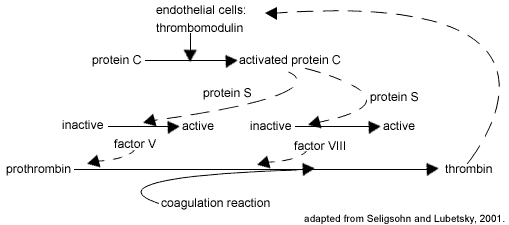Factor V Leiden and Venous Thrombosis Objectives
This website is archived for historical purposes and is no longer being maintained or updated.
 Educational objectives
Educational objectives
After reading this case study, you should be able to:
- identify key characteristics of the study population (cases and controls) that should be described when reporting results of gene-disease association studies.
- summarize gene-disease associations in terms of absolute, relative and attributable risks.
- discuss possible implications of the findings for researchers, people with Venous Thrombosis, and people with one or more of the newly described Factor V Leiden variants.
Introduction
Venous thrombosis is an important cause of morbidity; incidence is low in young people but increases with age to 1% per year in the elderly. In a small proportion of cases, venous thrombosis leads to pulmonary embolism, which can be fatal. Persons with an initial venous thrombosis are at increased risk for recurrence; however, long-term use of anticoagulant prophylaxis can result in major hemorrhagic complications. This challenging clinical problem has received new attention since the discovery of certain genetic variants that increase susceptibility to venous thrombosis.
Under normal conditions, procoagulant and anticoagulant factors in the blood are in balance. However, persons with inherited alterations in proteins that promote or prevent coagulation may be predisposed to excessive bleeding (as in hemophilia) or clotting (thrombophilia). Persons with thrombophilia are at increased risk of developing clots that obstruct blood flow locally or that detach and embolize. Environmental factors that cause vascular injury (e.g., surgery), stasis (e.g., prolonged immobility), or increased coagulability (e.g., hormone use) interact with genetic susceptibility to increase the risk for thrombosis.
Mechanisms controlling coagulation are complex, involving many different proteins. The schematic below represents a portion of the feedback mechanism that regulates the conversion of prothrombin to thrombin in the intrinsic pathway.

Resistance to activated protein C, a natural coagulant, was first described in 1993 and subsequently recognized as the most common cause of inherited thrombophilia. In most cases, it results from a point mutation in the factor V gene, G1691A, which slows the inactivation of factor V and thus favors conversion of prothrombin to thrombin.
- Case Study
Bibliography
- Seligsohn U, Lubetsky A. Genetic susceptibility to venous thrombosis. New Engl J Med 2001;344:1222-1231.
- Vandenbroucke JP, Koster T, Briet E, Reitsma PH, Bertina RM, Rosendaal FR. Increased risk of venous thrombosis in OC users who are carriers of factor V Leiden mutation. Lancet 1994;344:1453-157.
- Page last reviewed: June 15, 2009 (archived document)
- Content source:


 ShareCompartir
ShareCompartir